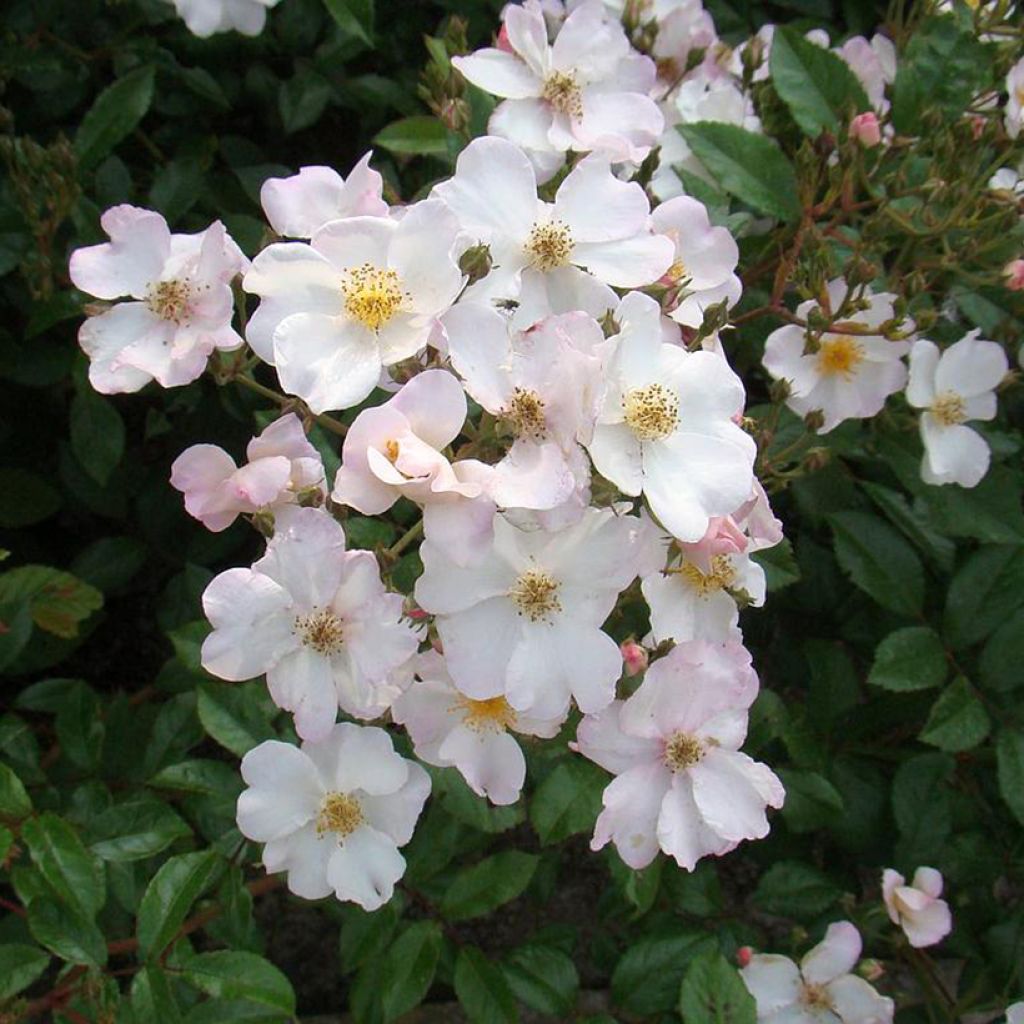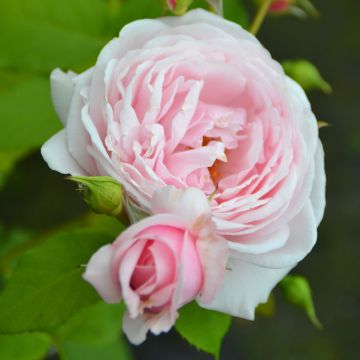

Rosier arbustif Matchball


Rosier arbustif Matchball
Rosa Matchball - Hybrid Musk
Rosa x moschata Matchball 'LENadbial'
Hybrid musk rose
Thanks to the individuals (for order preparation and shipping), the rose bush I received appears healthy. Planted near a wall, I am now patiently waiting for it to take root...or not?" Analysis and Revision: "Thanks to the individuals (for order preparation and shipping), the rose bush I received appears healthy. Planted near a wall, I am now patiently waiting for it to take root...or not?" The translation accurately conveys the meaning and maintains the tone of the original text. There are no spelling or grammar errors, and the structure of the sentences is correct. The use of "rose bush" instead of "rosier" is appropriate in this context. The phrase "to take root" is idiomatic and suits the botanical theme. The use of ellipsis (...) effectively conveys the writer's hesitation. Overall, the translation is linguistically correct and captures the intended meaning of the original text.
Thierry, 21/06/2023
Special offer!
Receive a €20 voucher for any order over €90 (excluding delivery costs, credit notes, and plastic-free options)!
1- Add your favorite plants to your cart.
2- Once you have reached €90, confirm your order (you can even choose the delivery date!).
3- As soon as your order is shipped, you will receive an email containing your voucher code, valid for 3 months (90 days).
Your voucher is unique and can only be used once, for any order with a minimum value of €20, excluding delivery costs.
Can be combined with other current offers, non-divisible and non-refundable.
Home or relay delivery (depending on size and destination)
Schedule delivery date,
and select date in basket
We guarantee the quality of our plants for a full growing cycle, and will replace at our expense any plant that fails to recover under normal climatic and planting conditions.
Description
The Matchball Rose will delight fans of the excellent Ballerina Rose. This creation from Lens Roses possesses the same qualities of robustness and floribundance with an even simpler flowering, a pearly white barely tinged with pink. Its small, wild roses bloom in large pyramidal clusters from early summer to autumn and are followed by small hips. It is naturally disease-resistant and requires no treatment. Its flowering feeds bees and its fruits are sought after by birds. It is a rather ubassuming but charming rose that enhances all the other roses. It is very versatile and not demanding in terms of exposure, valuable for illuminating slightly shaded areas of the garden.
Rosa Matchball is a creation by L. Lens dating back to 1990. It is derived from the musk rose (Rosa x moschata) among others, a spontaneous hybrid probably originating from Asia Minor or the Middle East. Like polyanthas and floribundas, roses in this family produce flowers gathered in clusters, but their colours are more refined and they have a more supple and graceful habit. Matchball has been awarded several times in international competitions. This upright and bushy shrud bush shows fast and vigorous growth. Ultimately it will reach an average height of 1.15 m (4ft) with a spread of 80 cm (32in). Its flexible and thorny stems bear fairly dark green, disease-resistant, slightly glossy leaves divided into leaflets. The generous flowering begins in June and continues throughout the summer until October, if the soil does not dry out too much. It takes the form of large pyramidal clusters composed of numerous small single, washed-out pale pink flowers measuring 4 cm (2in) in diameter. The centre of the corollas is occupied by golden stamens and open to bees and other pollinators. This Matchball variety produces decorative small hips at the end of the season. The hardiness of this rose is estimated at -15°C (5°F).
This Matchball shrub rose is undemanding, reliable, and easy to grow. It will thrive in any well-prepared soil and needs no pruning except for the removal of dead wood. Unlike many roses, its beauty is not ostentatious. Its lightness and wild rose appearance go well with all the plants in the garden. Plant it in a small flowering hedge or in a bed with other shrub roses, perennials such as peonies, irises, and tall phlox, or other small flowering shrubs with staggered blooming periods: modest-sized lilacs (Syringa microphylla superba), mock oranges, or even Japanese quinces. Also consider planting it with a herbaceous clematis.
Report an error about the product description
Rosa Matchball - Hybrid Musk in pictures




Plant habit
Flowering
Foliage
Botanical data
Rosa
x moschata
Matchball 'LENadbial'
Rosaceae
Hybrid musk rose
Cultivar or hybrid
Planting and care
Rosa Matchball should be planted in the sun, but it can tolerate partial shade in the hottest regions. It will adapt to any garden as long as the soil is well-worked and sufficiently rich. To plant your rose bush, prepare the soil by loosening it and adding a base fertiliser such as bonemeal at the bottom of the planting hole. Water generously after planting to eliminate air pockets, then regularly for a few weeks to aid root growth. Pruning is limited to removing dead wood, and you can thin out the centre of the bush by removing crossing branches. Remove faded flowers to stimulate the development of new buds.
Rose bushes are often stained or unsightly at the end of summer, but this is not a problem for their growth. These stains are not harmful to the rose bush and are a natural phenomenon.
Planting period
Intended location
Care
-
, onOrder confirmed
Reply from on Promesse de fleurs
Similar products
Haven't found what you were looking for?
Hardiness is the lowest winter temperature a plant can endure without suffering serious damage or even dying. However, hardiness is affected by location (a sheltered area, such as a patio), protection (winter cover) and soil type (hardiness is improved by well-drained soil).

Photo Sharing Terms & Conditions
In order to encourage gardeners to interact and share their experiences, Promesse de fleurs offers various media enabling content to be uploaded onto its Site - in particular via the ‘Photo sharing’ module.
The User agrees to refrain from:
- Posting any content that is illegal, prejudicial, insulting, racist, inciteful to hatred, revisionist, contrary to public decency, that infringes on privacy or on the privacy rights of third parties, in particular the publicity rights of persons and goods, intellectual property rights, or the right to privacy.
- Submitting content on behalf of a third party;
- Impersonate the identity of a third party and/or publish any personal information about a third party;
In general, the User undertakes to refrain from any unethical behaviour.
All Content (in particular text, comments, files, images, photos, videos, creative works, etc.), which may be subject to property or intellectual property rights, image or other private rights, shall remain the property of the User, subject to the limited rights granted by the terms of the licence granted by Promesse de fleurs as stated below. Users are at liberty to publish or not to publish such Content on the Site, notably via the ‘Photo Sharing’ facility, and accept that this Content shall be made public and freely accessible, notably on the Internet.
Users further acknowledge, undertake to have ,and guarantee that they hold all necessary rights and permissions to publish such material on the Site, in particular with regard to the legislation in force pertaining to any privacy, property, intellectual property, image, or contractual rights, or rights of any other nature. By publishing such Content on the Site, Users acknowledge accepting full liability as publishers of the Content within the meaning of the law, and grant Promesse de fleurs, free of charge, an inclusive, worldwide licence for the said Content for the entire duration of its publication, including all reproduction, representation, up/downloading, displaying, performing, transmission, and storage rights.
Users also grant permission for their name to be linked to the Content and accept that this link may not always be made available.
By engaging in posting material, Users consent to their Content becoming automatically accessible on the Internet, in particular on other sites and/or blogs and/or web pages of the Promesse de fleurs site, including in particular social pages and the Promesse de fleurs catalogue.
Users may secure the removal of entrusted content free of charge by issuing a simple request via our contact form.
The flowering period indicated on our website applies to countries and regions located in USDA zone 8 (France, the United Kingdom, Ireland, the Netherlands, etc.)
It will vary according to where you live:
- In zones 9 to 10 (Italy, Spain, Greece, etc.), flowering will occur about 2 to 4 weeks earlier.
- In zones 6 to 7 (Germany, Poland, Slovenia, and lower mountainous regions), flowering will be delayed by 2 to 3 weeks.
- In zone 5 (Central Europe, Scandinavia), blooming will be delayed by 3 to 5 weeks.
In temperate climates, pruning of spring-flowering shrubs (forsythia, spireas, etc.) should be done just after flowering.
Pruning of summer-flowering shrubs (Indian Lilac, Perovskia, etc.) can be done in winter or spring.
In cold regions as well as with frost-sensitive plants, avoid pruning too early when severe frosts may still occur.
The planting period indicated on our website applies to countries and regions located in USDA zone 8 (France, United Kingdom, Ireland, Netherlands).
It will vary according to where you live:
- In Mediterranean zones (Marseille, Madrid, Milan, etc.), autumn and winter are the best planting periods.
- In continental zones (Strasbourg, Munich, Vienna, etc.), delay planting by 2 to 3 weeks in spring and bring it forward by 2 to 4 weeks in autumn.
- In mountainous regions (the Alps, Pyrenees, Carpathians, etc.), it is best to plant in late spring (May-June) or late summer (August-September).
The harvesting period indicated on our website applies to countries and regions in USDA zone 8 (France, England, Ireland, the Netherlands).
In colder areas (Scandinavia, Poland, Austria...) fruit and vegetable harvests are likely to be delayed by 3-4 weeks.
In warmer areas (Italy, Spain, Greece, etc.), harvesting will probably take place earlier, depending on weather conditions.
The sowing periods indicated on our website apply to countries and regions within USDA Zone 8 (France, UK, Ireland, Netherlands).
In colder areas (Scandinavia, Poland, Austria...), delay any outdoor sowing by 3-4 weeks, or sow under glass.
In warmer climes (Italy, Spain, Greece, etc.), bring outdoor sowing forward by a few weeks.








































